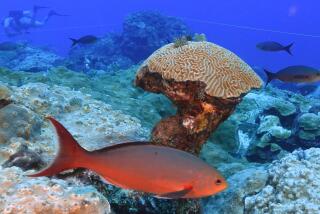Saving Seagrass Key to Health of Jersey Fisheries
- Share via
TUCKERTON, N.J. — Out here in Barnegat Bay, marine biologist Paul A.X. Bologna doesn’t have too look far to see the damage wrought by man.
Steering a 19-foot skiff into the shallows near Marsh Elder Island, he simply peers down into the shallow, bluish-gray water to find beds of seagrass gouged by the propellers of passing boats.
He can see blades of it so choked with algae -- and starved for light -- they can’t grow. The culprit: nitrogen-rich runoff from New Jersey’s densely developed coast, which ends up in the bay, causing algae that kill underwater vegetation.
There are telltale signs on the uninhabited island itself too: Chunks of land have fallen off its edges and into the bay, erosion caused by wave action that, had it been slowed by underwater vegetation, might not have been as powerful.
“Half the world, I think, looks at eelgrass as a nuisance, something that gets caught in your propeller,” Bologna said. “And that’s when they think of it at all. Since people don’t see it, they don’t think about it.”
But scientists do. Over the past 30 years, nearly 40% of the eelgrass acreage in Barnegat Bay has been lost because of coastal development and pollution.
Environmental officials warn that, left unchecked, the loss of seagrass could hurt tourism and fishing. Eelgrass serves as both nursery for tiny species and feeding ground for striped bass, blue crabs, hard clams and others.
With recreational fishing pumping more than $1 billion annually into the state’s economy, the potential loss of certain fisheries is cause for concern.
In Barnegat Bay, a 45-mile-long estuary along the New Jersey coast, the decimation of eelgrass beds has already played a part in the gradual extinction of bay scallops.
“Eelgrass is like the old canary in the coal mine,” said Tom Fote, legislative chairman for the Jersey Coast Anglers Assn., which represents 75 recreational fishing clubs. “We need to do more to bring back eelgrass than replanting. We need to find out why it dies.”
Bologna, a professor at Fairleigh Dickinson University, is among a group of researchers trying to turn the tide.
Using a $300,000 grant from the state Department of Environmental Protection, they are transplanting healthy eelgrass and widgeongrass plants and sowing seeds in an effort to restore hundreds of acres of barren bottoms.
The three-year project, which began in 2001, is aimed at documenting how established seagrass beds help reduce shoreline erosion, stabilize bottom sediments, expand fish and shellfish nursery grounds and reduce pollutants.
So far, it has resulted in the transplanting of two acres of eelgrass, the seeding of 0.2 acres and the transplanting of 0.2 acres of widgeongrass.
On a recent Thursday morning, Bologna, research assistant Paul Sokoloff and intern Beth Wolek boarded a rented skiff and set out from Causeway Boat Rentals and Marina in Manahawkin, motoring south until they reached the sites where they had already sown seeds.
There, they donned wetsuits and goggles and snorkeled in waist-deep water to check on the progress of their plants.
“When you have healthy grass beds, you have healthy water quality,” Bologna said. In some areas, transplanted eelgrass plants have shown survival rates of up to 90%. In others, storms have washed away the transplants.
“To be able to jump-start the process is great. We give Mother Nature a little help, but she’s the only one that can change this until we do something about the water quality,” he said.
From the state’s standpoint, eelgrass is more than an indicator of water quality. It can be used to improve it, according to Bradley Campbell, commissioner of the state environmental agency.
“The fact of the matter is that eelgrass beds can actually help maintain water quality by calming the water and reducing the kick-up of sediments, among other benefits,” Campbell said.
But experts say that seagrass can do only so much.
“People are transplanting seagrasses all over the world,” said seagrass expert Robert Orth, a professor at the Virginia Institute of Marine Science. “Wherever there are or have been seagrasses, people are looking at ways to reestablish beds. But if you don’t deal with the source of the problem, which is water quality, no matter how much you plant, they won’t survive.”
More to Read
Sign up for Essential California
The most important California stories and recommendations in your inbox every morning.
You may occasionally receive promotional content from the Los Angeles Times.













